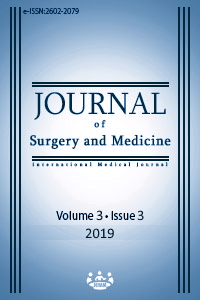When to apply propess to provide the best activity: In the morning or evening?
Keywords:
Chronotherapy, Labor induction, DinoprostoneAbstract
Aim: Propess is a drug of choice in our daily practice for induction of labor. The dosing plan of the drugs can be idealized by arranging them according to the chronobiological model. The aim of this study is to investigate the “time of administration” suggestions on chronotherapy for propess.
Methods: Our study was conducted retrospectively by examining the records of pregnant women who were given propess at Zekai Tahir Burak Women's Health Training and Research Hospital between 2008-2018. A total of 2694 patients were included in the study. Two groups were allocated according to the time of drug administration. The time from application to birth was calculated.
Results: Logistic regression analysis were performed for risk factors and we found that the time of drug administration was effective on duration to labor. The time from drug administration to labor was 18.0±4.0 hours in the morning group and 19.1±3.9 hours in the evening group (p<0.001)
Conclusion: It appears; drugs used for labor induction in the morning may increase drug efficacy and bioavailability. At this point birth becomes compatible with body biorhythm and the time to labor can be shortened.
Downloads
References
ACOG Committee on Practice Bulletins—obstetrics. ACOG practice bulletin no. 107. Induction of labor. Obstet Gynecol. 2009;114(3):86–97.
Alfirevic Z, Keeney E, Dowswell T, Welton NJ, Dias S, Jones LV, Navaratnam K, Caldwell DM. Labor induction with prostaglandins: a systematic review and network meta-analysis. BMJ. 2015;5(350):h217.
Coonrod DV, Bay RC, Kishi GY. The epidemiology of labor induction: Arizona, Am J Obstet Gynecol. 2000;18:1355-62.
Rodney KE, Douglas SR. Preinduction Cervical Assesment. Clinical Obstetrics and Gynecology. 2000;43:3440-6.
Aghideh FK, Mullin PM, Ingles S, Ouzounian JG, Opper N, Wilson ML, Miller DA, Lee RH. A comparison of obstetrical outcomes with labor induction agents used at term. J Matern Fetal Neonatal Med. 2014;27(6):592–6.
Geeta K, Swamy MD. Current methods of labor induction. Semin Perinatol. 2012;36(5):348–52.
Riboni F, Garofalo G, Pascoli I, et al. Labour induction at term: clinical, biophysical and molecular predictive factors. Arch Gynecol Obstet. 2012;286:1123-9.
Lemmer B. Chronopharmacology and controlled drug release. Expert Opin. Drug Deliv. 2005;2:667–81. doi: 10.1517/17425247.2.4.667.
Lemmer B. The clinical relevance of chronopharmacology in therapeutics. Pharmacol Res. 1996;33:107–15. doi: 10.1006/phrs.1996.0016.
Smolensky MH, Peppas NA. Chronobiology, drug delivery, and chronotherapeutics. Adv Drug Deliv Rev. 2007;59:828–51. doi: 10.1016/j.addr.2007.07.001.
Nainwal N. Chronotherapeutics A chronopharmaceutical approach to drug delivery in the treatment of asthma. J Control Release 2012;163:353–60. doi: 10.1016/j.jconrel.2012.09.012.
Boulvain M, Kelly AJ, Irion O. Intracervical prostaglandins for induction of labour. Cochrane Database of Systematic Reviews, 2008, Issue 1. Art. No.: CD006971. DOI: 10.1002/14651858.CD006971.
Kelly AJ, Malik S, Smith L, et al. Vaginal prostaglandin (PGE2 and PGF2α) for induction of labour at term. Cochrane Database of Systematic Reviews, 2012;5.
Caughey AB, Sundaram V, Kaimal AJ, et al. Systematic Review: Elective Induction of Labor Versus Expectant Management of Pregnancy. Ann Intern Med. 2009;151:252-63.
Cunningham FG, MacDonald PC, Gant NF, et al., eds. Williams Obstetrics. 2001,21th ed. Stamford, Conn.: Appleton & Lange.
Latendresse G. The interaction between chronic stress and pregnancy: preterm birth from a biobehavioral perspective. J Midwifery Womens Health. 2009;54(1):8–17.
Laursen, M. Hedegaard, M., & Johansen, C. Fear of childbirth: predictors and temporal changec among nulliparous women in the Danish National Birth Cohort. BJOG An International Journal of Obstetrics and Gynaecology. 2008;115:354-60.
Downloads
- 1387 2073
Published
Issue
Section
How to Cite
License
Copyright (c) 2019 Gül Nihal Büyük, Seval Sarıaslan, Hatice Kansu Çelik, Özlem Uzunlar
This work is licensed under a Creative Commons Attribution-NonCommercial-NoDerivatives 4.0 International License.
















